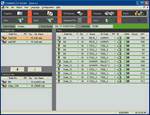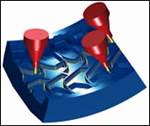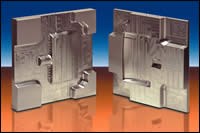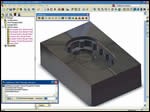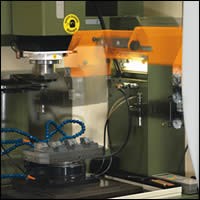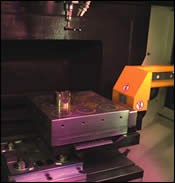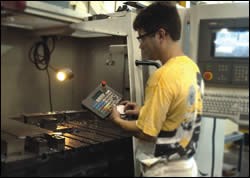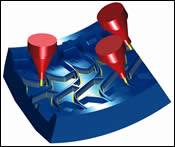Automation and Moldmaking: Mold Production in Action
Moldmakers are starting to change the way they think and incorporate automation into all aspects of their operation—combining a multitude of processes in a single cell for optimal productivity.
While automation has been around for some time now, it has recently been gaining prominence in the moldmaking industry as moldmakers continually strive to cut costs and shorten leadtimes while maintaining quality and accuracy in their never-ending quest to compete both domestically and internationally. Incorporating automation in all aspects of the mold design and build process will increase equipment utilization and streamline operations, but automating operations is no easy task—mold designers and manufacturers need to change they way they think about their processes and consider how each part of the design and build process can benefit through automation (see Examining the Process Sidebar).
Several leading manufacturers of machining equipment, EDM machines, software and components share their thoughts and experiences on the latest advancements in automation and what they mean to the shop in terms of the mold designer, engineer, moldmaker and mold assembler, as well as the process as a whole. They also discuss the challenges the industry faces in terms of automation and some recommended solutions to these challenges.
EDM/Machining
Advancements
Technologies like EDM and machining play a vital role in the increasing popularity of the use of automation in the mold design and build process. Gisbert Ledvon, marketing manager for Charmilles (Lincolnshire, IL)—an EDM equipment manufacturer—sees the industry shifting toward a “manufacturing approach” in the moldmaking industry. “Moldmakers have to think about cutting costs and setup times,” he explains. As a result, equipment manufacturers are creating “mold production cells” that were prominent at September’s IMTS show. “Cells should contain a high-speed graphite mill, preferably with high acceleration speeds of 1G and Glass scales on all axes for maximum accuracy and repeatability. The graphite milling machine should be connected to a robot who can feed two machines—in this case, a graphite mill and a diesinking machine. To minimize polishing time, the diesinking technology will be able to finish the mold part to a polished finish without manual polishing.”
According to Vice President of Sales Mal Sudhakar at Mikron U.S. (Lincolnshire, IL)—a provider of high-speed and high-performance machining centers—the key to success among leading mold shops in the U.S. has been the investment in modern high-speed machining and EDM technologies and in automation. “In the face of intense international competition to drive labor costs down and with the relentless pressure from the markets to reduce leadtimes, moldmakers have been increasingly automating their high speed machining and EDM processes,” he notes. “This trend will keep growing rapidly in the coming years. With 8,760 hours available in a year, a mold shop that runs a single shift is down to 2,000 hours. The actual machining times may be only 50 or 60 percent of the 2,000 hours—depending on the time spent in setups and job preparation. With automation, there is tremendous untapped potential to increase the productive capacity of HSM and EDM machines and to reduce labor costs and leadtimes. Further, this opens up the potential for a mold shop to process multiple jobs on the equipment—to further reduce leadtimes.”
The pressures of both domestic and global competition have led manufacturers to change the way they think and the way they work, asserts Henrik Sedvallson, CEO of System 3R USA Inc. (Totowa, NJ)—a supplier of manufacturing productivity tools. “Working smarter means obtaining greater manufacturing efficiencies and increased productivity,” he notes.
William Howard, a product line manager for Makino (Mason, OH)—a manufacturer of horizontal machining centers, vertical machining centers, wire EDM and ram EDM machines, and graphite machining centers—expands on these thoughts, adding that successfully employing automation on the shop floor is all about increasing equipment utilization to reduce—or even eliminate—the costs and time associated with “non-value-added time” in the manufacturing process. “Higher equipment utilization will actually reduce manufacturing costs by producing more parts in less time on the same machine,” Howard states. “In addition , by producing more—in the same timeframe—leadtimes will be reduced, which also impacts carrying costs associated with all elements of the moldmaking process (i.e. purchased components, equipment costs, raw material, etc.).
Like Charmilles’ Ledvon, Howard sees the industry streamlining the manufacturing process by consolidating multiple processes and operations onto a single machine, thereby reducing manufacturing complexity and the number of process steps, which helps improve part quality and precision, collapses the manufacturing time and makes the mold builder more responsive to the market. “Automation, in one form or another, facilitates all of the above advancements in the quest for global competitiveness in the moldmaking market.”
The following are specific advancements which impact automation, Howard points out:
- Automatic workchangers on VMCs (vertical machining centers) facilitate the setup/tear-down of one mold cavity/component while another is being manufactured. This can significantly increase the spindle utilization of the machine—and dramatically impact the machine utilization and throughput on a single spindle machine. The addition of a pallet changer also permits the unattended operation of the machine during nights and weekends—further reducing costs, increasing productivity and cutting leadtimes.
- Multiple part work changers (dedicated to a single machine) are another means of increasing the utilization of a machine by automating the flow of work a larger number and variety of work to/from the machine. Typically, these kinds of systems can be provided by the machine tool builder—or from a third-party vendor.
- Robotic loading offers a technique that could be used to automate the flow of work to/from a single machine (milling machine or EDM machine)—or multiple machines—depending upon the application. This approach can significantly increase the utilization of a machine (or grouping of machines) and dramatically impact the utilization and throughput. Dependent operations (i.e.: graphite electrode manufacturing and EDM’ing) could readily be combined into a lean production cell utilizing the robot as the common material handling component. Advanced software would manage the follow of electrodes and mold material to insure high productivity and performance to schedule. The addition of a robotic material handling system provides for a large (and expandable) queue of work pieces and material that further enhances the unattended operation of the machine (or machines) during nights and weekends.
Brad Evans, national sales manager of Alpha Workholding Solutions (Hartland, WI)—a manufacturer of permanent electromagnetic workholding and material handling products—also sees an increase in the use of robotic load and unload cells. “The additions of these cells will increase the productivity of the moldmaker while reducing the overall operational costs and reducing leadtimes,” he states.
Ledvon of Charmilles describes how these automated cells can impact the mold design and build process. “Looking at the work flow, graphite blocks are mounted on electrode holders (like System 3R Macro) and workpieces are mounted on pallets. Both are loaded in the robot magazine, and now the cell control software instructs the robot to load the electrode blanks into the milling machine The milling machine finishes the electrode and the robot loads it back into the electrode magazine. When some of the electrodes are finished the robot will load the electrode and workpiece blank into the diesinking machine, which will then complete the entire mold cavity including polishing. The next day or morning, the entire mold is made without human intervention. This is mold production in action.”
“Automation is the bridge between EDM and precision production,” adds System 3R’s Sedvallson. “The companies that cross that bridge are those that are sure to be successful.”
Mikron’s Sudhakar predicts an increasing availability of HSM and EDM machines with automation capabilities, more smart machining capabilities on machines to allow reliable unmanned operations, the integration of multiple processes such as HSM and EDM for the flow of both material and information, and the increasing use of a workshop management system to manage the complex flow of orders through the shop.
Challenges/Solutions
The first and foremost challenge to implementing automation in your shop is the obvious up-front cost, Howard of Makino asserts. “In an environment of extreme cost competitiveness among mold suppliers, it can seem counterproductive to invest capital in automation (i.e.: non-producing equipment) rather than additional machining or EDM capacity,” he stresses. “However, the investment in automation is the key to realizing much higher levels of utilization and reduced costs from either milling or EDM equipment. While it may seem counterintuitive (i.e.: investing a single penny more than the price of the basic equipment required for moldmaking), automation can significantly increase productivity, dramatically reduce costs, improve quality and reduce leadtimes.”
Expanding on Howard’s thoughts is Alpha Workholding Solutions’ Evans. “One of the greatest challenges facing moldmakers is the separation between the mold shops committed to process improvements and the ones not upgrading,” he comments. “If moldmakers do not automate, they will find it difficult to compete.”
Yet, Sudhakar of Mikron points out that some moldmaking equipment cannot be automated easily. “For example, a high-speed machining center may not be easily accessible for loading with a robot or even if it can be loaded, it hinders the normal accessibility to the machine for the operator,” he states. “The control also may not interface easily with a robot and even after all the issues are sorted out, the investment level may be quite high, which discourages the mold shop owner from investing in automation in the first place.
“However, when considering a new machine, the moldmaker should thoroughly evaluate the automation capabilities of a machine and the availability of low-cost automation solutions that exist in the market,” Sudhakar emphasizes.
Therefore, how to begin automating the shop can seem an insurmountable stumbling block for many moldmakers. “For those that recognize and understand the potential impact that automation could have on their business, the next question becomes ‘How do I get started?’” Howard notes. “The first step could be something as simple as adding automated load/unload capability to an existing machine—providing a quick, easy and productive method for increasing machine utilization and productivity by automating the flow of work in/out of the machine. Lightly attended or even unattended operations could an outgrowth of such a simple, initial step into automation.”
Once these initial steps produce results and the benefits of automation are recognized and quantified, Howard notes that the question then becomes one of “rolling-out” automation (by introducing additional automation into manufacturing processes to realize an even greater impact) and “lean manufacturing” techniques (that consolidate process steps, shorten or consolidate the machining operations, improve quality and collapse manufacturing leadtimes, etc.) to more of the mold manufacturing shop floor. “Using automation to increase machine utilization and recognize lightly attended or unattended operations has been discussed as an initial step,” he says. “Grouping dependent machines/operations and using automation to automate the flow of work between the machines (i.e., a robot cell integrating a graphite mill and an EDM machine) is the next plateau in streamlining moldmaking operations, increasing productivity, reducing costs and cutting leadtimes.”
Next, material handling automation, pallet changers, robots, etc. can be used to quickly and efficiently move raw material and tooling. “As equipment is more highly utilized, the response times of the support activities also will need to be addressed,” Howard states. “The traditional craftsmanship of the moldmaker must be captured in the pre-processing phase of the operations. CAD/CAM systems, tooling systems, part inspection techniques, etc. all must support a globally competitive mold building operation. Software for process management and planning must aid in getting parts quickly into and through the system—while DNC supports the download and distribution of data to the moldmaking shop floor.”
Once automation is in place, Mikron’s Sudhakar notes that some moldmakers face the following issues: can the automation be “trusted” to run reliably in unmanned operation and how can the flow of work be managed through the various processes. To address these issues, he notes that there are a number of “smart machining modules” available on high speed machining centers, which brings intelligence to the high speed machining process in order to improve process reliability, optimize machining performance and allow reliable unmanned operation. These modules include an advanced process system, intelligent thermal control, operator support system and remote notification system (see MoldMaking Technology, March 2006).
Beyond technology and equipment, Dave Lange, Director of Sales for the Americas for D-M-E (Madison Heights, MI)—a provider of mold bases and components, hot runner systems, mold controls and die cast tooling technology—advises moldmakers to scrutinize their processes to rise to the automation challenge. “Mold manufacturing setup is usually the first process to investigate whether time can be saved,” he says. “Today’s setup programs, tooling and toolchangers that are available have helped to minimize the actual machining time. If the spindle is not running or the electrode is not burning, non-production time is adding up.
“With the CNC equipment that is available today through high speed milling and EDM, the automation factor permits quicker setups with emphasis put on jigs and fixtures that can hold different sized parts accurately and be set up quickly,” Lange continues. “Fixture plates that could be set up ahead of time with the cavities or cores off the machine and then swapped out when the operations are completed with those already in the machine could cut hours—and could easily justify the price of the fixtures.” Automated machine cells can focus on cutting mold cavities. And, these cells will be increasingly capable of supporting hundreds of tool positions.”
Software
Advancements
According to Ben Mund, marketing manager of Tolland, CT-based Mastercam/CNC Software, Inc.—a manufacturer of software tools for CAD/CAM manufacturing markets—shops are being forced to change how they work and the shops that are willing to invest in the latest technology and embrace automation will be the ones to stay competitive. He also points out that the prevalence of multiaxis machines has led software manufacturers to provide more efficient software. “An example is shops’ ability to quickly program increasingly affordable multiaxis machines—which is a key element to getting a good return on their investment,” he comments. “New software applications increase both the finish and tool life, while decreasing machining time to get parts cut more quickly. Without these benefits, shops may not be getting the full competitive edge that these machines can bring to them.
“From a software manufacturer’s point of view, automation allows the end-user to take advantage of multiaxis machines and high speed toolpaths to machine hardened steel (or other hard materials), whereas prior to this, the parts would require more tooling and would add more processes to their operations (such as hardening after machining, more polishing of the part, and more operations to finish the model),” Mund continues. “With multiaxis machines, a single setup replaces multiple setups on conventional three-axis machines, and the bottom line is there is less labor required to produce the same mold. Multiaxis machining is a key to automation and this trend will continue in the future.”
Over at Teksoft, Inc. (Scottsdale, AZ)—a provider of CAM products for CNC machining (milling, turning, wire EDM and
fabrication)—CEO Mike Coleman predicts additional non-geometric information, such as surface finish and tolerances, being attached to the model—resulting in further programming automation and added user control over the machining results. “In addition, we foresee three-axis machining algorithms that become ‘smarter’ to take advantage of work in process machining and other common shop methods,” he states. “This will ultimately produce more efficient and effective toolpaths that will significantly accelerate the machining process.”
Challenges/Solutions
Mastercam’s Mund points out that it is challenging for moldmakers to make engineering changes to parts that have already been programmed. “These changes may only be trivial edits to an existing model, but that may have already invested time programming the original part,” he comments. “Now, when a change needs to be made, what do they do? Rather than reprogramming the entire part, it would be much more efficient to identify the change and only reprogram that area. CAD/CAM software can help shops do this. Change Recognition is a feature that can actually identify changes in incoming files (from different formats like solids and surfaces), read the changes, and then determine what is different in that file and can help quickly program just those elements. This is much quicker then having to redo the part from scratch, which many shops would have had to do in the past.”
Another automation software challenge moldmakers may run into is software that automates the shop but doesn’t allow the operator to override it when necessary. “Shops need control over every aspect of their software, if you choose to have that much control in it,” Mund comments. “While automation is a great thing, nothing replaces the experience of an actual moldmaker no matter how good that software is! A shop needs software they using to be “open” enough that they can go in and have complete control over it any aspect of it.”
According to Teksoft’s Coleman, sometimes it is difficult for moldmakers to see that not all components of a mold require three-axis machining. “For example, components such as slides are prismatic in nature and can benefit from an advanced Automatic Feature Recognition (AFR) features, which analyzes the part geometry and defines the most common machineable features for milling.” Furthermore, knowledge-based machining technology can take over from that point. “The automation engine then instinctively generates and associates machining operations and parameters for each feature,” Coleman explains. “Thus, even in moldmaking, machining operation sequences can be predefined and automatically applied when machining similar components.”
In addition, some software packages’ knowledge-based principles are fully customizable to optimally represent your current machining environment, Coleman says. An adaptable, self-populating, standard establishing database helps prevent the all too common scenario where a shop’s efficiencies and competitive advantages are dependent on an individual programmer’s proprietary knowledge and experience.
Hot Runners/Components
Advancements
Another area of the mold manufacturing process that is trending more toward automation is hot runners. D-M-E’s Lange reports that 15 years ago one in 10 tools was a hot runner mold, today that number is closer to five in 10. “In the closure industry, automating the process to run fully automatic (24/7) for high production custom and captive molders is an effective way to stay competitive,” he comments. “And, these cells will be increasingly capable of support hundreds of tool positions.”
Lange also notes that mold change and color change on the same product also may be required. “Three plate molding is being replaced with hot runner molding in order to decrease cycle time and reduce material waste,” he notes. “The processor also is doing more than just molding the part. The automated processes of pad printing, hot stamping, gluing, assembling and packaging are now a part of getting the business. The days of ‘clip and ship’ are gone. The functions of labor-intensive secondary operations are quickly being entirely automated. Processors cannot afford to compete domestically and globally if human hands have to touch the parts after they’ve been molded. Printing, inserting, two-color, multi-component, and multi-material functions must be done without manual interaction.”
In the mold control area of the process, cavity pressure control of the molding machine is becoming increasingly important. Lange notes that controllers are being developed that yield close loop control of the process—thus correcting for other variations such as percent regrind, varying mold cooling temperatures and aging presses in general. “A controller’s improved slaving function provides the capability to create an offset in power between the master and slaved zone, thus allowing for some compensation in power output to correct for variations in heater tightness, heater wattage, mold cooling variations and the like.”
Challenges/Solutions
D-M-E’s Lange emphasizes that using automation to save time and labor costs is particularly effective in lean manufacturing environments. “As shorter leadtime demands continue to be placed on moldmakers, it is imperative that efficient planning get the jobs through their shops as quickly as possible by making maximum use of their capabilities and equipment,” he states. “Opportunities for automation in a mold shop may require more planning, as they have to be more adaptable, but these opportunities exist,” Lange says. “To thrive in today’s moldmaking environment, we must find the areas where unproductive time can be eliminated. High performance machining is an increasingly important aspect of how automation will aid moldmakers.”
Solutions to these challenges lie in turning to emerging mold technologies, or established technologies that have previously not been widely used. “Spin and spin stack molds are becoming more popular,” Lange notes. “Rotational molds and machine platens are more prevalent than ever. These technologies were once only for larger operations, but now even 15- to 20-man shops are making multi-component, core back, rotational molds. Automation in a moldmaking shop has to be adaptable to enable work with shorter runs of parts versus a fixed set of automated equipment. Automated machine cells can focus on cutting mold cavities.”
The Long Haul
Equipment, component and software manufacturers are in agreement that automation is the key to a moldmaker’s long-term survival in a global economy. While it may be an enormous endeavor that forces each employee to plan in advance how the work will flow through the shop and critically examine each and every aspect of the mold design and build process, the results are worth it. Shorter delivery times, reduced labor costs and decreased leadtimes await the moldmaking shops that can change their methods of thinking and embrace the world of automation.
Related Content
MMT Chats: Injection Molds and Integrated Solutions Through Ambition and Innovation
Jordan Robertson, VP, Business Development and Marketing for StackTeck discusses various mold technologies to improve efficiencies in automation, cooling, lightweighting and sustainability.
Read More2024 Moldmaking Insights: A Year in Review Part 1
A look back at the top moldmaking trends of 2024, as revealed through MMT's analytics. This review highlights the most popular technical articles, case studies, tips and best practices that captured the industry's attention over the past year.
Read MoreOvercoming Barriers to Automation Integration in Precision Moldmaking
It’s easy to imagine the advantages automation offers the moldmaking process, but it's challenging to change one’s mindset, develop a plan and invest.
Read MoreAutomating Mold Polishing With AI-Powered Robotics
Empowering human workers and harnessing the precision of AI-driven robots may help streamline the polishing process for some molds and tooling.
Read MoreRead Next
Process Management Leads to Easier Automation
Before you move your shop into full blown automation, integrate a pallet system and process management software.
Read MoreAutomation and Moldmaking: Streamling Processes
Automation is coming into the forefront as moldmakers are on the hunt to automate with software and equipment to streamline processes for optimal productivity—and quality.
Read MoreHow to Use Strategic Planning Tools, Data to Manage the Human Side of Business
Q&A with Marion Wells, MMT EAB member and founder of Human Asset Management.
Read More
